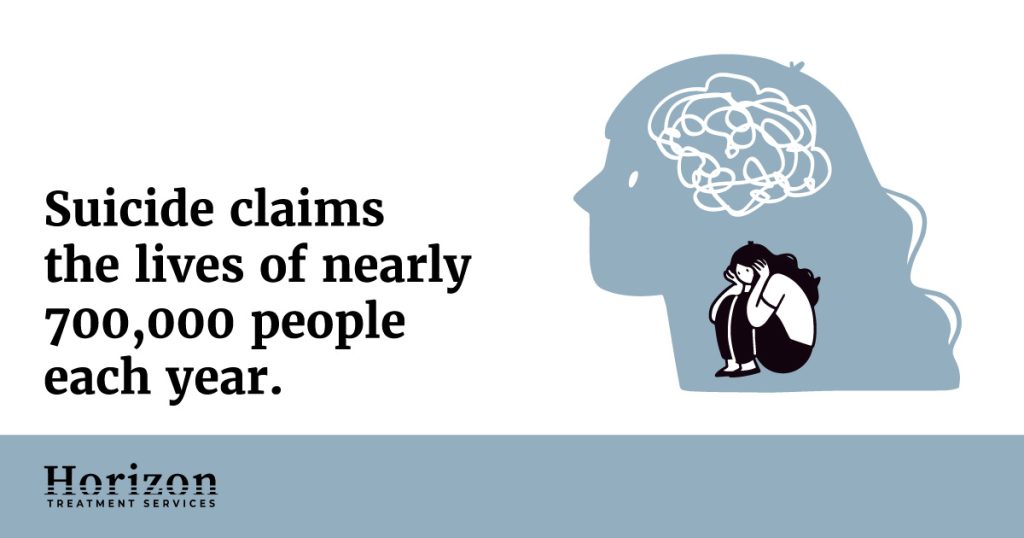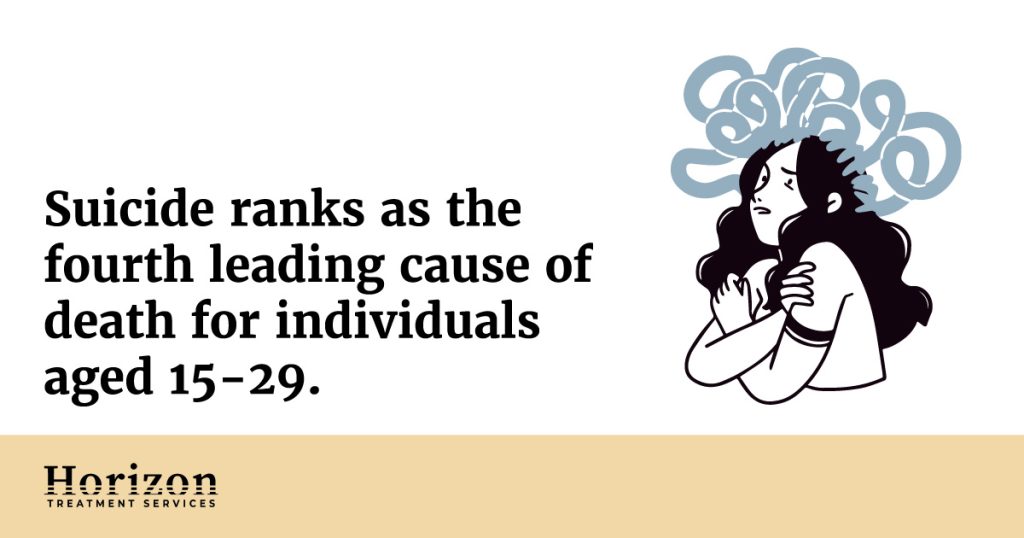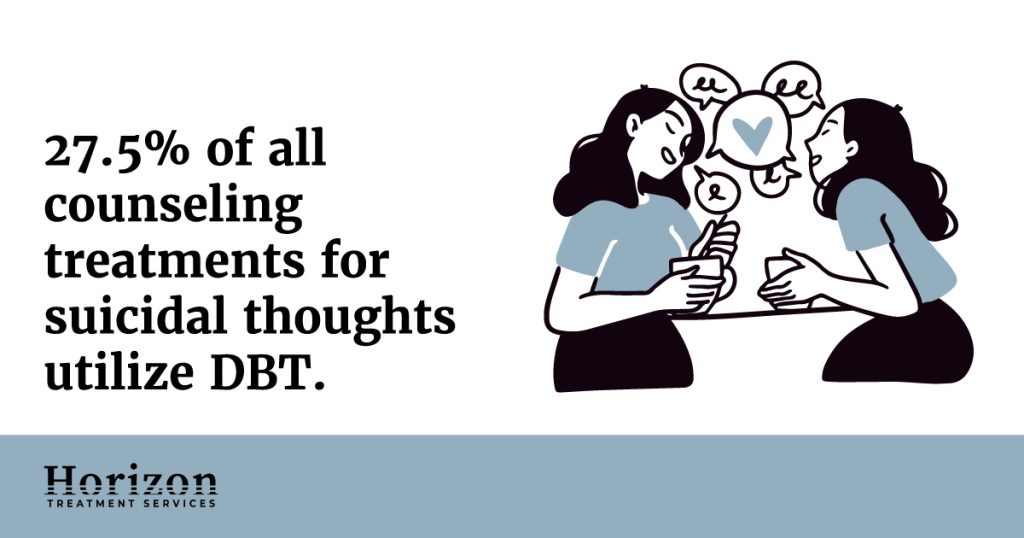What Does California Suicide Prevention Entail?
Suicide claims the lives of nearly 700,000 people each year.1 It ranks as the fourth leading cause of death for individuals aged 15-29.2 California suicide prevention is a crucial aspect of mental health care that aims to reduce the risk of suicide.
Suicide prevention provides support for individuals who may be experiencing suicidal thoughts or tendencies. A few ways to help expand resources and education for California suicide prevention include:

California Suicide Prevention: Promoting Mental Health Awareness
Promoting and educating others about mental health is crucial. Sometimes, people may not ask for help because they’re worried about what others will think. By learning more about mental health and being supportive, we can encourage others to seek help when they need it.
Providing Accessible Resources
Having easy-to-reach resources is very important for California suicide prevention. There are helplines and counseling services available to anyone who needs them. These resources are there to help people in tough times so they don’t feel alone.
At Horizon Treatment Services, we strive to aid individuals in understanding substance use disorder and mental health issues. Our aim is to offer continuous, reliable support for their path to recovery. This includes providing mental health resources to those experiencing suicidal thoughts or ideations.
California Suicide Prevention Treatment Strategies
https://youtube.com/watch?v=fTIrHMuwHcQ%3Fcontrols%3D1%26rel%3D0%26playsinline%3D0%26modestbranding%3D0%26autoplay%3D0%26enablejsapi%3D1%26origin%3Dhttps%253A%252F%252Fwww.horizonservices.org%26widgetid%3D1
Support for At-Risk Groups
Suicides among adults aged 35-64 make up 46.8% of the total in the United States.3 Certain groups, such as LGBTQ+ individuals, veterans, and those with a history of mental health issues, are at a higher risk of suicide.
California suicide prevention efforts include providing targeted support to address their specific needs.
Creating Supportive Communities
Having caring and supportive communities is a big part of California suicide prevention. When people feel included and have a community around them, they’re more likely to feel supported and cared for. Community events and groups that bring people together can make a difference.
Crisis Intervention and Support
When someone needs help right away, crisis hotlines are there to listen and provide support. They’re open 24/7 so that anyone in crisis can talk to someone who understands and cares.4
Integrating Mental Health into Healthcare
Taking care of mental health is just as important as physical health. Doctors and healthcare providers can screen for mental health concerns and give the right support and treatment. Also, physical health and mental health directly impact each other, so taking care of one is imperative for taking care of the other.

What Are Some of the Prominent California Suicide Prevention Strategies and Initiatives?
Suicide prevention initiatives are important in helping people who might feel hopeless. They aim to reduce suicide and support those in need. Below are some of the strategies that can make a difference in preventing suicide.5
Enhance Economic Support
To help people who are struggling with finances and feeling overwhelmed, there are two important programs that can help:
- Financial Support Programs: Programs that provide money and support to those who need it can include things like unemployment benefits and help with everyday expenses. This can help those struggling with everyday finances.
- Job Stability and Security: Having a stable job and fair pay is often essential for mental health, especially with today’s economy. Helping provide stable work can help individuals work through financial problems.
Improve Access and Delivery of Suicide Care
It’s important to make sure that people have access to mental healthcare when they need it. Improving access to care can provide individuals with the support necessary for recovery.
Mental Health Services
Making mental health care more available and affordable for everyone means having more mental health professionals available to all populations.
Holistic Training
Teaching people like teachers and healthcare providers how to recognize signs of suicide risk and respond in the right way can help connect those in need with the right support.
Promote Healthy Connections
Having supportive communities is important for preventing suicide. Some supportive resources include:
- Community Awareness Campaigns: Spreading the word about California suicide prevention and reducing stigma can encourage people to seek help. This can be done through educational programs and events.
- Peer Support Programs: Groups where people can share their experiences and support each other can help those at risk feel less alone.
Identify and Respond to Individuals in Crisis Effectively
To help those in immediate crisis, treatment centers and healthcare professionals can provide:
- Screening and Assessment: Regularly checking in on mental health can help identify those at risk of suicide and get them the help they need.
- Care Coordination and Follow-Up: Creating coordinated care plans and following up after a crisis can reduce the risk of future attempts. By following these strategies, we can make a positive impact on suicide prevention and help those in need find hope and support.
What Are Some Therapies Used in California Suicide Prevention Counseling or Treatment?
California suicide prevention counseling is essential for supporting people with suicidal thoughts or ideations. Below are some important counseling techniques to consider:
Dialectical Behavior Therapy (DBT)
DBT is for those who struggle with emotions and self-destructive behaviors. It combines cognitive-behavioral therapy with mindfulness and acceptance.
DBT teaches coping skills, emotional regulation, healthy relationships, and self-acceptance. 27.5% of all counseling treatments for suicidal thoughts utilize this treatment.6
What is DBT?: A Closer Look
https://youtube.com/watch?v=lDnvZS5DP68%3Fcontrols%3D1%26rel%3D0%26playsinline%3D0%26modestbranding%3D0%26autoplay%3D0%26enablejsapi%3D1%26origin%3Dhttps%253A%252F%252Fwww.horizonservices.org%26widgetid%3D3
Cognitive-Behavioral Therapy (CBT)
CBT is a common counseling technique that helps change negative thoughts and behaviors. It teaches better coping skills and problem-solving, which are important in California suicide prevention. CBT challenges unhelpful beliefs and teaches how to handle tough emotions.7
Motivational Enhancement Therapy (MET)
MET focuses on boosting motivation and commitment to change. It’s used early in treatment to help people think about their behavior and reasons to change. MET uses listening and support to increase self-motivation.
Eye Movement Desensitization and Reprocessing (EMDR)
EMDR helps those who face traumatic events or symptoms, such as those associated with PTSD. It uses eye movements or other bilateral body movements to process traumatic memories and emotions safely. EMDR aims to reduce emotional pain and lower suicide risk.
Trauma-Focused Therapy
This technique helps people who experienced trauma, such as abuse or violence. It uses techniques from CBT and exposure therapy. Trauma-focused therapy aims to help individuals cope with trauma, reduce distress, and prevent suicidal thoughts.
How Does Horizon Treatment Services’ Individual and Group Counseling Aid in California Suicide Prevention?
At Horizon Treatment Services, we offer individual and group counseling in our programs. The aim is to help people with substance use and co-occurring behavioral health issues.
In individual counseling, you get to talk privately with a counselor about your feelings and struggles. The counselor gives you support and guidance to cope with substance use and other challenges.
In group counseling, you join others facing similar issues in a friendly setting. You can share experiences, learn from each other, and develop skills to handle substance use and behavioral health concerns better.

What Programs Are Being Implemented to Create Safer Environments for Students?
Schools use different programs to make sure students are safe and happy. Let’s explore some of these programs.
Anti-Bullying Programs
Anti-bullying programs teach students and teachers about the effects of bullying and how to be kind. Students are encouraged to report bullying, and victims get the support they need if they have been bullied. These programs work to make the school a friendly and caring place for everyone.
Mental Health Awareness Initiatives
These programs teach students about emotions and mental health. They show that it’s okay to talk about feelings and ask for help. By understanding mental health, students can support each other better.
Positive Behavior Intervention and Support (PBIS)
PBIS helps students learn good behavior. They are praised for positive actions, which help reduce problem behaviors. This makes the school a respectful and friendly place.8
Conflict Resolution Programs
These programs teach students to solve problems calmly and in a healthy manner. By learning how to talk things out, students can avoid fights and create strong communication skills.
Substance Use Disorder Prevention Initiatives
These programs tell students about the dangers of drugs and alcohol. They teach students how to make good choices and say no to peer pressure. The goal is to keep the school drug-free and safe.
Building Futures: How Project Eden’s Youth Services Program Transforms Students’ Lives
The Youth Services Program at Horizon Treatment Services helps students in several school districts, including:
- Hayward
- San Lorenzo
- San Leandro
- Castro Valley
We provide substance use prevention, intervention, and treatment to schools and communities. We also offer:
Psycho-Educational Support Groups
We have special groups where students can talk openly and feel safe. Trained professionals lead these groups and help students learn about important topics like staying away from drugs, making good decisions, and dealing with stress.
Counseling for Substance Use Disorder
We understand that substance use disorder can be tough for students. That’s why we offer counseling to help them understand the risks and find better choices. We want to support them in overcoming addiction and living healthier lives.
Decision-Making and Problem-Solving
We believe that making good decisions is important. We help students learn how to make smart choices and solve problems effectively. This way, they can handle challenges with confidence.
Conflict Resolution Techniques
Conflicts happen, but we teach students how to resolve them peacefully. By learning better communication and problem-solving skills, they can build positive relationships with others.
Crisis Intervention
If a student is going through a tough time, we are here to help right away. Our trained staff provides immediate support and connects them to the right resources.
How Does Early Education About Mental Health Help With California Suicide Prevention?
Teaching kids and young adults about mental health is crucial to prevent suicide. When they learn to understand and manage their feelings, it promotes positive mental health and reduces suicide risks.
Below are some important points to consider in this regard:
The Importance of Early Education
Early education helps kids take care of their mental health. Learning about emotions and coping strategies and seeking help empowers them to develop a healthy mind. This education should start early, like in elementary school, to build a strong foundation for understanding emotions.
Coping Strategies
Kids learn to handle tough situations and stress. Deep breathing, mindfulness, and creativity are effective tools for managing emotions.
How Do Online Resources Impact Intervention and Awareness?
Online resources have revolutionized mental health support and awareness, reaching those facing challenges or considering suicide:
- Information Access: The internet provides information about mental health conditions. It helps people understand and seek help.
- Anonymous Support: Online forums offer support while keeping people’s identities private. This safe space is vital for those feeling hesitant or embarrassed to talk about struggles.
- Counseling: Online counseling makes mental health services accessible to everyone. This connects people with licensed professionals from their homes.
- Community and Awareness: Social media raises mental health awareness. Sharing stories and educational resources reduces stigma and encourages open conversations.

What Are the Key Indicators or Warning Signs of Suicide Risk?
It’s important to know the signs of suicide risk to help prevent tragedies and support those in need. By recognizing these signs, we can take action to help with California suicide prevention.
Here are some important signs to watch for:9
- Changes in Behavior: When someone is at risk, they might avoid friends, lose interest in things they enjoy, or struggle in school or work.
- Increased Isolation: Another sign is when someone isolates themselves from others. They might stop joining social activities and keep away from loved ones.
- Expressing Hopelessness: People thinking of suicide may talk about feeling hopeless, worthless, or like a burden.
- Giving Away Possessions: Sometimes, people at risk give away their things or make plans. They might share sentimental items or talk about not needing anything anymore.
- Changes in Mood: Sudden and strong mood swings can be a sign of risk. If someone seems very angry, sad, or overwhelmed, they may need help with their mental health.
- Talking About Death or Suicide: When someone talks about death or suicide, we must take it seriously. It might be a plea for help or a serious intention. We need to listen, show concern, and encourage them to get professional support.
What is Suicidal Ideation?
https://youtube.com/watch?v=AecNqFk8glo%3Fcontrols%3D1%26rel%3D0%26playsinline%3D0%26modestbranding%3D0%26autoplay%3D0%26enablejsapi%3D1%26origin%3Dhttps%253A%252F%252Fwww.horizonservices.org%26widgetid%3D5
How Are Mental Health Professionals Helping Individuals With Treatment?
Mental health professionals play a crucial role in supporting individuals with mental illness. They offer compassionate care and evidence-based counseling to improve emotional well-being.
Here are the ways mental health professionals help individuals with treatment:
- Counseling: Talking with a mental health professional is essential. They help people explore their thoughts and feelings.
- Helping in Crisis: If someone is having a really hard time, professionals step in to help right away. They make sure the person is safe and give them support.
- Support Systems: Health professionals help people create support networks with family and friends. They also make plans to stay safe during tough times.
- Checking Progress: Professionals stay in touch to see how people are doing. They make sure the treatment is helping and make adjustments if needed.
- Collaboration: Mental health professionals team up with other experts like doctors, teachers, and social workers. They work together to help the person in every way they can.
What Can Individuals and Communities Do to Actively Engage in California Suicide Prevention Advocacy?
California faces significant challenges with suicide rates and how people view mental health. To help prevent suicide, individuals and communities can employ multiple strategies. Below are important points to consider in this regard:
Promote Mental Wellness
To stop suicide and break the stigma, communities can:
- Seek Support: Tell people it’s okay to ask for help when they feel down. Encourage them to talk to family, friends, or mental health experts.
- Take Care of Yourself: Show people how to take care of their mental health by exercising, sleeping well, eating healthy, and doing things they enjoy.
- Connect with Others: Help people make friends and be part of the community. They can join clubs, do activities, and talk to others.
Educate Others
Teaching is important to reduce stigma and make people understand mental health. People and communities can:
- Share Resources: Give out information about mental health resources and help centers in the community. They can make brochures, websites, and events with mental health experts.
- Hold Workshops: Organize workshops to teach about mental health and California suicide prevention. These workshops may take place in schools, workplaces, or community groups.
- Help Youth: Teach parents and community members how to support young people’s mental health. They can talk about mental health in schools, start mental health programs, and give resources to students.
Advocate for Change
To speak up for California suicide prevention and fight the stigma of mental health, people and communities can:
- Support Laws: Keep up with mental health laws in California. Support plans to get better mental health services, more money for mental health, and ways to stop suicide.
- Talk to Local Government: Go to meetings with the local government and talk about mental health. Ask for more mental health services, campaigns to raise awareness, and rules to help mental wellness.
- Share Personal Stories: Tell people to share their own mental health stories. This makes it easier to talk about and to stop the stigma. They can speak at events, do campaigns online, or join mental health events.

How Can Horizon Treatment Services Help Provide Resources for California Suicide Prevention?
Horizon Treatment Services is dedicated to providing compassionate support to individuals facing mental health challenges. We offer essential recovery and wellness programs across multiple locations.
Palm Avenue Detox: Taking the First Step
Palm Avenue Detox is a critical first step in recovery for those with substance use and behavioral health issues. We serve men, women, trans, and non-binary individuals.
Our detoxification process is safe and comfortable. The average stay is five days, but some with severe symptoms can stay up to two weeks.
Cronin House: A Safe Place to Heal
At Cronin House, we have a safe and caring environment for people dealing with substance use and mental health issues. This program is for male-identifying individuals. We provide personalized care and counseling for up to 90 days to help them heal and feel better.
Chrysalis Women’s Residential: Help for Women
Chrysalis is for women aged 18+ in Alameda County with mental health and substance use disorders. With up to 90 days of stay, it offers personalized treatment and support to empower women in their recovery.
Project Eden: Help for All Ages
Project Eden is a program that supports people of all ages dealing with substance use disorder. We help children, teens, adults, families, and communities in Hayward and San Lorenzo. Our experienced team uses a holistic approach to make a positive impact on their lives.
Project Eden Adult Outpatient: Strengthening Recover
Project Eden Adult Outpatient Services Program supports adults in their recovery journey. We offer individual and group counseling. Individuals can openly discuss their challenges, emotions, and progress in a safe space that fosters a sense of community.
Get Help Today
Need more information on our programs? Take the first step towards a brighter tomorrow! Contact Horizon Treatment Services today. Let’s work together to create a positive change in your life.
Resources
1https://www.who.int/health-topics/suicide#tab=tab_1
2https://www.who.int/news-room/fact-sheets/detail/suicide
3https://www.cdc.gov/suicide/facts/disparities-in-suicide.html
4https://www.cdph.ca.gov/Programs/CCDPHP/DCDIC/SACB/Pages/Crisis-Hotlines–Resources.aspx
5https://www.cdc.gov/suicide/prevention/index.html
6https://www.ncbi.nlm.nih.gov/pmc/articles/PMC6389707/
7https://deploymentpsych.org/treatments/Cognitve-Therapy-for-Suicidal-Patients-CT-SP
8https://www.samhsa.gov/resource/ebp/positive-behavioral-interventions-supports-pbis-practice-guides
9https://www.samhsa.gov/blog/suicide-warning-signs-prevention-strategies-older-adults








